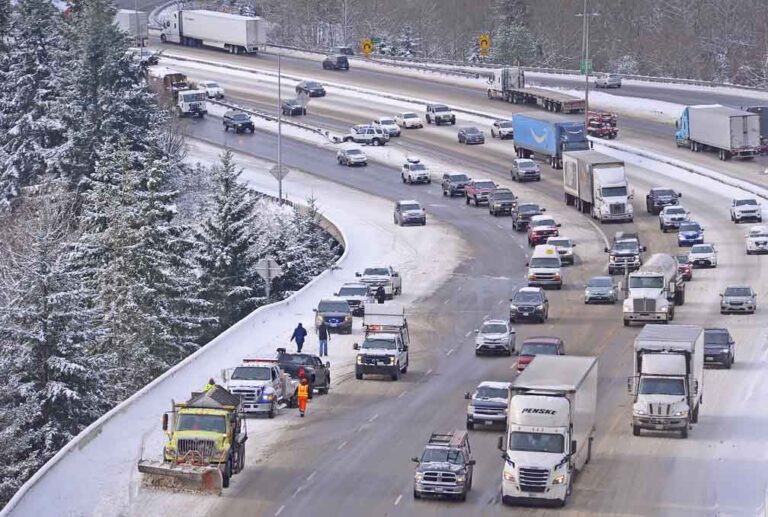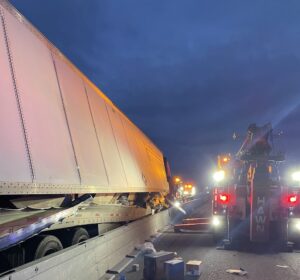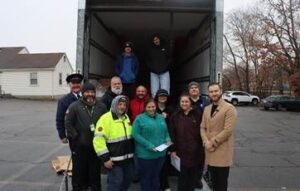SEATTLE — Wild winter storms have wreaked havoc from the Pacific northwest to California and Minnesota over the past several days, dumping mounds of snow, icing over key travel arteries and creating thousands of accidents.
And it’s made the life of a trucker that much harder on the road.
A major Christmas weekend storm caused whiteout conditions and closed key highways amid blowing snow in mountains of Northern California and Nevada, with forecasters warning that travel in the Sierra Nevada could be difficult for several days.
That’s where professional driver Sal Tucker and his big rig were parked at a truck stop trying to wait out the storm. He has a delivery that’s due in Los Angeles this week.
“It’s been a nightmare, man,” Tucker said. “Running behind, mad customers. Everyone wants it right now, but it ain’t happening with this weather.”
The National Weather Service issued a blizzard warning for much of the southeastern portion of North Dakota and a winter storm warning for the eastern and central parts of the state through Monday evening.
Authorities were still advising people not to travel across much of that state and complained that motorists were getting stuck on secondary roads that were not plowed. Many county offices were closed expect for emergency services.
The Minneapolis Star Tribune reported snowfall totals ranging from less than 2 inches to almost 3 inches in the Twin Cities. Freezing temperatures and drizzle have glazed the new snow with ice, making for slow going on roads and treacherous footing on sidewalks.
Other areas in central and northern Minnesota got more snow. Little Falls reported 5 inches and Grand Marais reported 13 inches. The Minnesota State Patrol reported it had responded to 189 crashes on state highways between noon Sunday and 8 a.m. Monday, along with 200 vehicles that slid off roadways and eight jackknifed semis.
Authorities near Reno said three people were injured in a 20-car pileup on U.S. Route 395, where drivers described limited visibility on Sunday.
Tee Hill, a professional driver from Dallas, said she was caught in the traffic backup associated with that wreck on 395. She said it took hours to get free of the congestion.
“Pick one. The weather, crazy drivers, snow, wind, fog. It’s all out here, and it’s bad,” Hill said. “I just want to tell folks to be careful and be respectful out here on the roads. Nothing is worth more than a life. So, I will be late. That is better than someone digging my grave.”
Further west, a 70-mile stretch of Interstate 80 was shut until at least Monday from Colfax, California, through the Lake Tahoe region to the Nevada state line, costing millions as semi trucks full of goods are stuck on both sides of the closure awaiting clearer weather.
The economic impact of the lengthy closure was felt Monday morning at Nevcal Trucking in Sparks, where dozens of empty semi trucks were parked. When I-80 shuts down, it creates havoc.
“If the trucks are not running, the drivers aren’t making money, the company’s not making money” Nevcal Safety Director Matthew Andersen told mynews4.com.
Emergency warming shelters were open throughout western Washington and Oregon as temperatures plunged into the teens and forecasters said an arctic blast would last for several days.
Sunday’s snow showers blew into the Pacific Northwest from the Gulf of Alaska, dumping up to 6 inches across the Seattle area. More than a foot was reported near Port Angeles across the Puget Sound on the Olympic Peninsula. Portland, Oregon, also received snowfall. Icy roads will make the commute challenging in Seattle, Portland and elsewhere.
Forecasters said more snow was likely for the Portland metro area, with up to 3 inches possible by Tuesday morning.
But officials were especially worried about the extreme cold.
Temperatures in western Washington and Oregon aren’t forecast to rise above freezing until at least Thursday, and possibly not until the weekend. Several days of below freezing temperature is rare for the region, which typically has mild, rainy winters.
“It’s just, you know, they’re talking right now like it’s going to be, you know, four or five days before we get above freezing again. So, you know, this is not a short event,” said Keith Hughes, of West Seattle American Legion Hall Post 160, where a warming center was set up up to a dozen people.
Hughes said capacity was limited by a lack of volunteers.
“Volunteers, this is a problem for myself as well as everyone else in town, it’s really hard to get with COVID going on,” he said.
Multiple daily cold records were broken. The National Weather Service said Seattle’s low Sunday was 20 degrees F, breaking a mark set in 1948. Bellingham was 9 degrees F, three degrees colder than the previous record set in 1971.
In Portland in the early part of the week, overnight temperatures will get down to the low teens.
State officials in Oregon have declared an emergency.
In Multnomah County — home to Portland — six severe weather shelters are open with plans to open additional sites, including at the Oregon Convention Center.
“We expect many more people to need a warm place to sleep as temperatures drop and more snow is forecast,” said Julie Sullivan-Springhetti, the county communications director.
On Sunday night officials said the shelters were at 63% capacity with 248 people — most of whom are experiencing homelessness.
Seattle city leaders also opened at least six severe weather shelters that will remain open through the new year, city officials said Monday. Nearly 200 people stayed at the shelters overnight on Sunday, officials said, and they were expecting the numbers to grow.
Kaety West took refuge at the center in West Seattle, leaving her tent just a few blocks from it.
“I’m not even willing to stay in it right now. It’s just so difficult,” she said.
Meanwhile, a winter storm made life in North Dakota and Minnesota tough Monday morning.
The Bismarck Tribune reported the storm dumped 6 inches of snow on Bismarck on Sunday. Authorities closed Interstate 94 between Bismarck and Fargo and Interstate 29 from Grand Forks to the South Dakota border. The entire interstate system in the state had reopened by 4 p.m.
Forecasts call for frigid temperatures after the storm moves through, with Friday highs in Bismarck expected to top out at minus 10.
Highs in the Twin Cities are expected to range from 10 degrees to minus 10 the rest of the week.
Winter storms also blasted freezing air and blinding snow across northern Nevada on Monday, affecting travel and business, with Sierra Nevada highway passes closed, airport flights delayed and canceled and state offices shut down.
Washoe County Emergency Management raised the avalanche danger to high for areas north of Lake Tahoe.
Nevada Gov. Steve Sisolak issued an order late Sunday telling nonessential state workers other than public safety and corrections personnel to remain home Monday.
Tire chains or four-wheel drive were required for vehicles on California and Nevada state highways and on U.S. 6 and U.S. 50.
U.S. 395 was closed in Washoe Valley after at least two wrecks sent at least six people to hospitals, the Truckee Meadows Fire Protection District said.
Weather and travel advisories were in place on most roads across northern Nevada, with the National Weather Service in Elko warning of difficult driving due to wind gusts greater than 40 mph and the possibility of blowing and drifting snow.
The University of Nevada, Reno and Truckee Meadows Community College canceled on campus in-person operations and classes.
The National Weather Service in Reno extended a weather advisory in Nevada to 7 p.m. Monday.
Frigid cold was expected to remain for most of the week, with high temperatures in the Reno area in the 20s and lows in the teens. Low temperatures in northeast Nevada were expected to be in the single digits.
In California, the Department of Transportation closed many other roads while warning of slippery conditions for motorists.
“Expect major travel delays on all roads,” the National Weather Service office in Reno, Nevada, said Sunday on Twitter. “Today is the type of day to just stay home if you can. More snow is on the way too!”
The weather service issued a winter storm warning for greater Lake Tahoe until 1 a.m. Tuesday because of possible “widespread whiteout conditions” and wind gusts that could top 45 mph.
Turbulent weather stretched from San Diego to Seattle. More than a foot of snow was reported near Port Angeles on Washington state’s Puget Sound. Portland, Oregon received a dusting, but the city was expected to get another 2.5 inches by Monday morning, according to the weather service.
In California, rockslides caused by heavy rain closed more than 40 miles of coastal Highway 1 in the Big Sur region south of the San Francisco Bay Area. There was no estimate for the reopening of the scenic stretch that is frequently shut after wet weather.
The latest in a series of blustery storms hit Southern California with heavy rain and wind that flooded streets and knocked down power lines late Saturday.
In the San Bernardino Mountains east of Los Angeles, crews were repairing a section of State Route 18 that washed down a hillside after heavy rain late Thursday. The closure of the major route into the Big Bear ski resort area could last for weeks, officials said.
Back in Minnesota, professional driver “Little T” Jackson said he was going toward the Twin Cities when roads started getting icy. He said he feels blessed that he wasn’t a part of one of the many wrecks reported there.
“Just slow down,” Jackson said. “I saw many of my fellow trucking brothers and sisters either slid off the road or involved in wrecks. There isn’t much you can do when it gets this bad. Get off the road if you can when it gets this bad.”
The Associated Press contributed to this report.
The Trucker News Staff produces engaging content for not only TheTrucker.com, but also The Trucker Newspaper, which has been serving the trucking industry for more than 30 years. With a focus on drivers, the Trucker News Staff aims to provide relevant, objective content pertaining to the trucking segment of the transportation industry. The Trucker News Staff is based in Little Rock, Arkansas.















